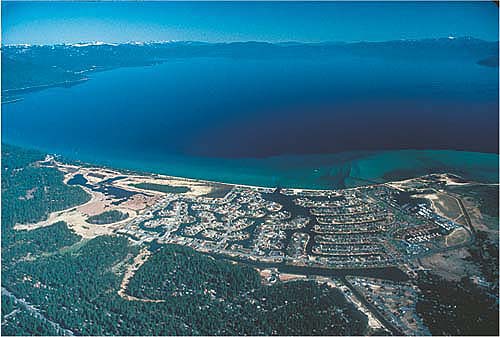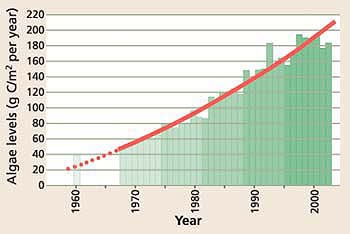All Issues
Science a decisive factor in restoring Tahoe clarity
Publication Information
California Agriculture 60(2):45-46.
Published April 01, 2006
PDF | Citation | Permissions
Full text
Western settlers first discovered Lake Tahoe in 1844, when General John Fremont and his tired group of cavalry gazed upon its cobalt waters from a mountaintop to the southwest. For the next century, stagecoaches brought steadily increasing summer visitors. When Mark Twain first saw Tahoe he was so impressed by its blue waters that he described it as the “fairest picture the whole earth affords.”
The 1857 discovery of gold and silver in the Comstock Lode at Virginia City created the first major disturbance of the Lake Tahoe Basin. Loggers clear-cut most of the basin's timber to shore up the mines of the Comstock; when the mines ran out of silver most of the old-growth timber was also gone.
White fir and brush grew back in dense, overcrowded stands, which in recent years have created a major fire hazard. This revegetation was important, however, in slowing the high soil-erosion rates that characterized the peak logging period. The high losses of soil, chronicled in lake sediments, dropped back to less than one-quarter of those that occurred during the lumbering activity.
Lakes are reservoirs of history. Their bottom sediments are an indelible record of what has occurred on land, air and water. The sediments of the Tahoe Basin are thought to contain a continuous 1-million-year record of climate, one of the longest on the continent. Fossil remains of invertebrates and fish scales portray the postglacial history of Lake Tahoe, beginning about 11,000 years ago. More recent sediment layers preserve sawdust from the Glenbrook sawmills of the Gold Rush, chronicle the introduction of tetra ethyl lead in gasoline in 1948, and record the appearance of mercury from industrial atmospheric pollution.
When the Comstock mining ended, forests and brush cover returned to the basin within about 20 years, and with it Tahoe recovered its pristine quality as one of the clearest large lakes in the world. In 1887, John Le Conte measured the lake's transparency at over 100 feet, a revelation that provides hope that the lake can once again recover from the recent period of high development activity.
Over 70% of the Tahoe Basin is U.S. Forest Service land under the control of the federal government. After World War II, developers built roads and structures using flatland technology unsuited to the steep slopes, fragile soils and limited vegetation cover of this subalpine area. In the late 1950s, when the value of wetlands was not well understood, approval was given for Dillingham Corporation to develop a marina on Pope Marsh, the single largest wetland in the Sierra Nevada. This became the extensive Tahoe Keys at the south end of the lake, and the important filtering capacity of Pope Marsh was lost forever. To make things worse, the major tributary to the lake, the upper Truckee River, was relocated along the east side of the Tahoe Keys and now delivers nutrients and sediment directly to the lake without the filtering benefits of the former wetland. (Scientists have proposed that it be diverted into the narrow remaining marsh known as Cove East.)
Tahoe Keys contains warmer water than that of the lake, and it has provided habitat for a number of invasive plants and animals. These invasive species, now exemplified by the spread of the notorious waterweed Eurasian watermilfoil, have gradually moved from the Keys to other areas around the lake. Warm-water and aquarium fish introduced to the Keys have moved to the new, warmer microenvironments that the waterweeds have created. Other invasive fish, particularly the cold-water-tolerant smallmouth bass, may eventually threaten the very existence of the native minnow, trout and kokanee salmon populations. The invasion of these exotic organisms will be further aided by the gradual warming of the lake. Tahoe's enormous volume of 39 trillion gallons (156 cubic kilometers) of water has already warmed nearly a full degree Fahrenheit over the last 30 years.
With the construction of casinos at the state line on the north and south ends of the lake and the development of a summer boating and winter ski industry, Tahoe gradually attained the status of a resort destination. The lake is so popular in the summer that it is not unusual to record a million vehicle miles around the lake in a single day. The selection of Tahoe for the 1960 Winter Olympics gave it global publicity and greatly increased the visitor traffic. The beauty of this lake is now world-renowned, but human impacts have gradually taken their toll.
Since my lake clarity and algal productivity studies began in 1959, the lake has lost a third of its remarkable transparency, and algal growth has increased by about 5% per year (see figures below and on page 50 ). Small particles of dust and sediment remain suspended in the water column for years, adding to the gradual but relentless transparency loss. Air pollution is also a factor; nitrogen pollution of the lake is greater from the atmospheric deposition than it is from stream-water input.
This limnological research (which examined the physical, chemical and biological features of the lake) convinced civil and environmental engineers to require the total export of treated and untreated sewage from the Tahoe Basin. Although the availability of a basinwide sewage system probably stimulated additional near-shore development, this export was a major and necessary step in preserving water quality. The success of sewage diversion strengthened the realization that keeping Tahoe blue was difficult, but achievable. Also instrumental in building public awareness were articles in the journal Cry California and the growing influence of the League to Save Lake Tahoe, which translated the scientific data collected by the UC Tahoe Research Group into lay terms. As the league's membership grew, so too did an understanding of the growing threats to Lake Tahoe's water quality. “Keep Tahoe Blue” bumper stickers began to appear across California and Nevada.
Several landmark decisions have been made since my arrival at Lake Tahoe in 1958. Creation of the Tahoe Regional Planning Agency, for example, brought a single central authority to a lake divided by two states, five different counties, and various municipalities, agencies and local governments. This federal mandate was unpopular in some circles, since it imposed federal control on two states. However, it provided essential coordination of efforts to regulate future development and repair the damage that had already been done. Another historic decision came in 1984, when U.S. District Judge Edward Garcia halted development in the basin for 2 years until control measures could be established to protect the resource. Strong, science-based evidence has been the decisive factor in successfully defending the Tahoe Regional Planning Agency from legal assaults over the years.
The Tahoe Keys development on the lake's south shore destroyed Pope Marsh and put part of the Truckee River into a canal, so that it now delivers nutrients and sediment directly to the lake without the filtering benefits of the former wetland.
In 1997, at the invitation of current U.S. Senate minority leader Harry Reid (D-Nev.), President Bill Clinton and Vice President Al Gore attended the first Lake Tahoe Summit, a unique environmental event that gained worldwide attention. The Tahoe Summit is now held annually, and Reid and U.S. Senator Dianne Feinstein (D-Calif.) have continued to champion protection of the lake. This fall the UC Davis Tahoe Environmental Research Center will move into a new world-class facility that will greatly expand research, education and science-based decision-making for the Tahoe Basin.
After more than a century and a half of development and disruption since Western settlers first discovered Tahoe, the lake remains extraordinarily beautiful and remarkably clear. It is one of the West's most treasured resources. We have now moved beyond most of the conflicts of the past. Developers and conservationists generally agree that everyone loses if Tahoe's water quality and scenic beauty are allowed to deteriorate. New scientific discoveries on lake temperature and nutrients, and watershed ecology, together with developments in monitoring and adaptive management, give further promise for the future of the lake. There is growing public understanding of the value of this unique natural resource and increasing willingness to do whatever is necessary to protect Tahoe for this and future generations.







